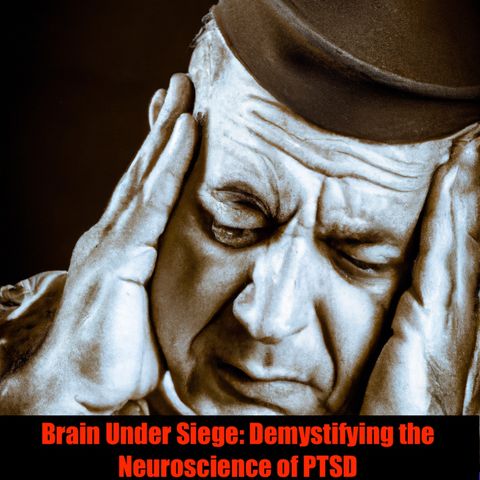PTSD What We Know and What we Don't

Descarga y escucha en cualquier lugar
Descarga tus episodios favoritos y disfrútalos, ¡dondequiera que estés! Regístrate o inicia sesión ahora para acceder a la escucha sin conexión.
PTSD What We Know and What we Don't
Esta transcripción es generada automáticamente. Ten en cuenta que no se garantiza una precisión absoluta.
Descripción
Post-traumatic stress disorder, or PTSD, is a complex disabling psychiatric condition that can develop after someone experiences or witnesses a profoundly disturbing, frightening or life-threatening event. The trauma triggers a...
mostra másWho PTSD Impacts PTSD can impact anyone who has gone through severe emotional or physical trauma regardless of gender, age, nationality or background. However, certain populations face disproportionately higher risk including:
- Military veterans exposed to combat violence - Victims of violent crimes like sexual assault, child abuse, domestic violence, mugging, terrorism - Refugees fleeing warzones, persecution or natural disasters - First responders handling catastrophic accidents with casualties - Patients surviving critical health episodes through emergency interventions
Not everyone exposed to trauma develops PTSD which depends on unique risk factors like trauma severity, available social supports, inheritance patterns, childhood adversity levels, and tendency for dissociation or panic responses. But an estimated 8 million American adults have PTSD in a given year with women twice as likely to develop it as men. Global prevalence ranges between just under 4% in peace regions to over 15% in conflict areas.
PTSD Causes & Symptoms
When external threats like violence or accidents trigger the body’s natural survival “fight or flight” stress response, a flood of adrenaline, cortisol and neurotransmitters alter functioning for quick reaction. Heart rate elevates. Pupils dilate scanning for danger as breathing intensifies circulating oxygen to large muscles prepping to confront the threat. Non-essential bodily processes like digestion shut down to conserve energy for emergency alertness.
Under normal circumstances when threats pass, the parasympathetic nervous system kicks in a calming hyper-aroused “fight or flight” response bringing equilibrium. But for PTSD sufferers this off-switch fails leaving systems stuck in overdrive cycles of hypervigilance exhausting the mind and body long after the crisis stabilized. The traumatic memory imprints intense associations linking environmental cues to overwhelming panic. The psyche struggles to integrate shattering experiences outside normal realms into a cohesive understanding of self and world.
Core PTSD clusters include: 1) Intrusive memories forcibly reliving the trauma through flashbacks, nightmares, and emotional/physical distress when recall triggers manifest 2) Avoidance of people, places or scenarios reminiscent of the events. Emotional numbing, withdrawal, and selective amnesia lock trauma in the subconscious but sap joy too. 3) Negative thought/mood shifts like survivor’s guilt, shame, difficulty recalling details worsened by lack of sleep or irritable overreactions 4) Heightened arousal levels through aggressive, erratic or self-destructive behavior. Hypersensitivity manifesting as constant anxiety hampers function
PTSD Treatment Method History & Options
As greater numbers returned from 20th-century wars or survived accidents that would have killed previous generations, psychological trauma echoes became increasingly apparent. But medical understanding evolved slowly from dismissing shell shock and battle fatigue as cowardice to linking PTSD onset to neurological changes.
1950’s-60’s Treatments Though still mistaken as rare rather than widespread among survivors, early roots of formal interventions emerged via: - Psychoanalytic talk therapy allows the discharge of avoided memories - Anxiety and arousal reduction techniques like hypnosis or systematic desensitization joint with cathartic flooding exposure methods
1970’s-80’s Trauma Therapy As Vietnam veteran’s advocacy broadened PTSD perspective, treatment incorporated further techniques: - Cognitive processing therapy focusing on stuck trauma beliefs blocking growth - EMDR intensive memory stimulation while incorporating bilateral eye movement - Group talk sessions to normalize common symptoms among populous building support - Medications like SSRIs alleviating anxiety, depression and insomnia also helped manage (not cure) distress
Integrative 21st Century Gold Standards Today's “gold standard” consensus favors combining therapies in coordinated 12-week programs: - Stabilizing symptoms through SSRIs to establish a safe baseline - Education on PTSD brain adaptations providing self-compassion - Altering misassigned danger associations using systematic desensitization - Challenging distorted automatic thinking through cognitive techniques - Carefully progressively exposing patients to avoided trauma narratives via writing, telling or virtual reality while preventing destabilizing overwhelm
Additional promising options gaining evidence include: - FDA research ongoing around using MDMA or cannabis derivatives to amplify talk therapy benefits - Mindfulness-based stress reduction through trauma-sensitive meditation/yoga protocols - Transcranial magnetic stimulation targeting memory emotional intensity centers - Ceremony or ritual to construct coherent trauma narrative with communal support
Broader PTSD societal destigmatization and trauma-informed care also spread concentrating not just on individual treatment but transforming systems preventing compounding harms. While PTSD remains challenging, better-recognizing prevalence and integrating survivors back into supportive communities aids healing.
In summary, PTSD constitutes a very treatable but often difficult condition arising from exposure to severely distressing events outside normal experience flooding healthy coping reserves. Growing knowledge around root causes, brain changes and gold standard multi-modal treatments continues progressing prognosis, functionality and support networks for impacted individuals through societal change accelerating destigmatization. But by increasing awareness and emotional intelligence around trauma responses we all gain the power to foster post-traumatic growth over paralysis. Thanks for listening to Quiet Please. Remember to like and share wherever you get your podcasts.
Información
| Autor | QP-2 |
| Organización | William Corbin |
| Página web | - |
| Etiquetas |
Copyright 2024 - Spreaker Inc. an iHeartMedia Company

Comentarios